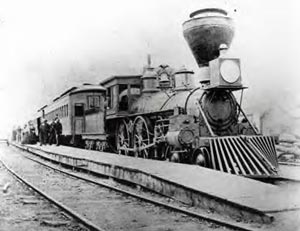Trains
The first steam powered train

The invention of the steam engine (see Industrial Revolution) was critical to the invention of the modern railroad and trains. In 1803, a man named Samuel Homfray decided to fund the developement of a steam-powered vehicle to replace the horse-drawn carts on the tramways.
Richard Trevithick (1771-1833) built that vehicle, the first steam engine tramway locomotive. On February 22, 1804, the locomotive hauled a load of 10 tons of iron, 70 men and five extra wagons the 9 miles between the ironworks at Pen-y-Darron and the town of Merthyr Tydfil in Wales. It took around two hours.
The first railroad

In spite of the Civil War, Abraham Lincoln signed the Pacific Railroad Act of 1862 giving permission to begin the first transcontinental railroad. One of the central routes was chosen; from Omaha, Nebraska to Sacramento, California.
The Union Pacific Railroad (1,038 miles long) began constructing a line west of Omaha while the Central Pacific (742 miles long) started east from Sacramento. After incredible hardships the two railroads were joined together at Promontory, Utah, on May 10, 1869. The last spike driven into the rail ties was made of gold.